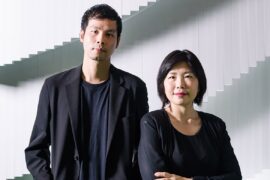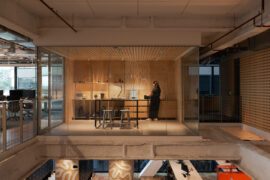London’s China Design Centre is a new platform for Chinese brands and suppliers to showcase their work to a European audience, writes Ola Bednarczuk.

July 1st, 2014
The China Design Centre opened its doors in early May and is quickly beginning to establish itself as a destination for experiencing the breadth of Chinese creativity in design and architecture. As design in China undergoes somewhat of a revolution, the Centre’s mission is to chart the country’s shift from a hub for low-cost mass manufacture to a country with its own flourishing design culture.
The Centre’s opening exhibition, “From Made in China to Designed in China”, provides a snapshot of China’s contemporary design scene by highlighting the works of fifteen designers across product design, furniture, ceramics, architecture, architectural products, art and craft. It’s a diverse offering and a fascinating starting point for anyone unfamiliar with China’s burgeoning modern design scene. Hand-painted ceramics from Asianera sit alongside contemporary-meets-classic timber furniture by Hou Zheng Guang, Zhang Zhoujie’s geometric-inspired steel designs and scale architecture models by the likes of HWCD’s Sun Wei and Vector Architects’ Gong Dong.
Founder and Director Jack Qu describes the China Design Centre as “a window for Chinese designers to show the excellence of Chinese design to the world” as well as a place to promote collaboration between UK and Chinese designers. A rotating exhibition and talks programme will look at design and architecture issues facing both regions, as well as creating a cultural exchange. The Centre is currently gathering submissions from Chinese architecture and design students from universities across London, ready for an upcoming exhibition of emerging UK-based design talent which will then travel to China later in the year.
The China Design Centre has already garnered much support from the UK architecture industry. Its location within central London’s The Building Centre – a hub for education about the built environment – has opened it up to London’s close-knit and engaged design community.
“It’s really important that there is a centre for Chinese design in London; you have to have a face-to-face connection with Chinese people, Chinese designers and [UK] designers,” said Angela Brady, architect and former president of the Royal Institute of British Architects (RIBA) at the Centre’s launch.
Sir Terry Farrell of Farrell & Partners, the notable British architect whose work includes major commercial works across the UK and China, agreed that knowledge sharing within the international design industry is essential.
“China has to get out there [and] have China Design Centres everywhere,” he said. “Design is becoming global and Chinese designers have to compete internationally, just as European designers and architects have competed in China.”
China Design Centre
chinadesigncentre.com
INDESIGN is on instagram
Follow @indesignlive
A searchable and comprehensive guide for specifying leading products and their suppliers
Keep up to date with the latest and greatest from our industry BFF's!
The new range features slabs with warm, earthy palettes that lend a sense of organic luxury to every space.

A longstanding partnership turns a historic city into a hub for emerging talent
The internet never sleeps! Here's the stuff you might have missed

Featuring beloved Melbourne designers, this is a must-attend conversation for emerging designers and anyone interested in the pursuit of creativity.

Practicing architecture and giving back to the next generation of students, Jenchieh Hung of HAS design and research is ensuring that the landscape of Thailand is in very good hands for the future.

The second installment in our three-part series on collaborations between the world’s best designers and the American Hardwood Export Council

The Arup Workplace in Perth/Boorloo, designed by Hames Sharley with Arup and Peter Farmer Designs, has been awarded The Work Space at the INDE.Awards 2025. Recognised for its regenerative design, cultural authenticity, and commitment to sustainability, the project sets a new benchmark for workplace architecture in the Indo–Pacific region.